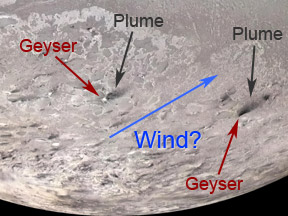At sea level, the atmosphere exerts pressure on Earth at a force of 14.7 pounds per square inch.
Click on image for full size
Courtesy of the FAA
Atmospheric Pressure
Pressure is an idea scientists use to describe how gases and liquids "push" on things. The atmosphere has pressure. If you imagine a column of air that is 1 inch square and goes from the Earth's surface all the way up through the atmosphere, the pressure of the air in that column is 14.7 pounds per square inch. Now that may seem like a lot of pressure pressing down on your body if you think of how many square inches it takes to cover your body! But pressure is a force that is spread out over an area. So all of that pressure is not a force pushing down, but a force spread over your entire skin, hair, fingernails and so on.
Atmospheric pressure is not always the same. If a low pressure system or a high pressure system is passing over your house, that will change the atmospheric pressure.
Air pressure also changes as you go up!
The air pressure in Earth's atmosphere is pretty strong when you are near sea level. When you go higher up, in an airplane or to the top of a mountain, there is less pressure.
Temperature also affects atmospheric pressure. Warmer temperatures will make atmospheric pressure go up.
The highest recorded atmospheric pressure, 32.06 inches of Mercury, happened in Mongolia, December 19, 2001. The lowest pressure (outside of those measured in tornadoes) was 25.69 inches of Mercury in the Western Pacific during Typhoon Tip on October 12, 1979.
Atmospheric pressure is measured in many different units.
You might also be interested in:

Even though we can't see air, it is real and has pressure. The pressure of the atmosphere changes. It is higher at sea level, and lessens as you go higher up in the atmosphere. Some weather systems have
...more
The Walker circulation is an ocean-based system of air circulation that influences weather on the Earth. The Walker circulation is the result of a difference in surface pressure and temperature over the
...more
A barometer is a weather instrument used to measure atmospheric pressure. The first barometer was invented in 1643 by Evangelista Torricelli, one of Galileo's assistants. This first barometer used mercury
...more
Weather balloons are used to carry weather instruments that measure temperature, pressure, humidity, and winds in the atmosphere. The balloons are made of rubber and weigh up to one kilogram (2.2 pounds).
...more
How many hurricanes will form this year? How strong will they be? While no one can say for sure, teams of scientists make predictions each year about the strength of the upcoming hurricane season. To make
...more
Rain is precipitation that falls to the Earth in drops of 5mm or more in diameter according to the US National Weather Service. Virga is rain that evaporates before reaching the ground. Raindrops form
...more
Triton is by far the largest moon of Neptune. It is slightly smaller than Earth's Moon. The surface of Triton is colder than the surface of any other planet or moon in our Solar System. It is so cold on
...more














